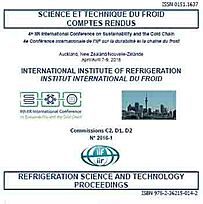
IIR document
Carbon reduction opportunities for supermarkets.
Author(s) : EVANS J. A., MAIDMENT G. G., BROWN T., et al.
Summary
Refrigeration is the largest load in a supermarket, accounting for 50-60% of the electricity consumption. Supermarket refrigeration systems also generate greenhouse gas emissions directly through refrigerant leakage. Technologies that can save direct and indirect emissions in a typical baseline UK supermarket were examined and the application timescales and cost per tonne of CO2 abated were calculated using a model of the supermarket. Using the model, the technologies that could save the most carbon were identified. The work examined 81 different technologies and their potential to save direct and indirect emissions in supermarkets. Results from the work have shown that most technologies either save CO2e emissions from reduction in energy or from reduction in refrigerant leakage only a few technologies demonstrated savings from both.
Available documents
Format PDF
Pages: 8
Available
Public price
20 €
Member price*
Free
* Best rate depending on membership category (see the detailed benefits of individual and corporate memberships).
Details
- Original title: Carbon reduction opportunities for supermarkets.
- Record ID : 30017565
- Languages: English
- Subject: Technology
- Source: 4th IIR International Conference on Sustainability and the Cold Chain. Proceedings: Auckland, New Zealand, April 7-9, 2016.
- Publication date: 2016/04/07
- DOI: http://dx.doi.org/10.18462/iir.iccc.2016.0042
Links
See other articles from the proceedings (63)
See the conference proceedings
Indexing
-
Annex 31: advanced modelling and tools for anal...
- Author(s) : ARIAS J., LUNDQVIST P., SAWALHA S., et al.
- Date : 2010/03/29
- Languages : English
- Source: 1st IIR International Conference on Sustainability and the Cold Chain
- Formats : PDF
View record
-
Building better supermarkets for the world.
- Author(s) : FISCHER J., DANFOSS
- Date : 2023/06
- Languages : English
View record
-
Achieving energy efficiency in small grocery st...
- Author(s) : EKMAN M., SWÄRDSJO D., ARIAS J.
- Date : 2013/04/02
- Languages : English
- Source: 2nd IIR International Conference on Sustainability and the Cold Chain. Proceedings: Paris, France, April 2-4, 2013.
- Formats : PDF
View record
-
Soluzioni integrate ed avanzate per il risparmi...
- Author(s) : FERRARESE T.
- Date : 2013
- Languages : Italian
- Source: Industria & Formazione - vol. 37 - n. 366
- Formats : PDF
View record
-
MEUBLES FROID : LIMITER LA CONSOMMATION ENERGET...
- Author(s) : VALDENAIRE A.
- Date : 1984/03
- Languages : French
- Source: Filière Viande - n. 65
View record
